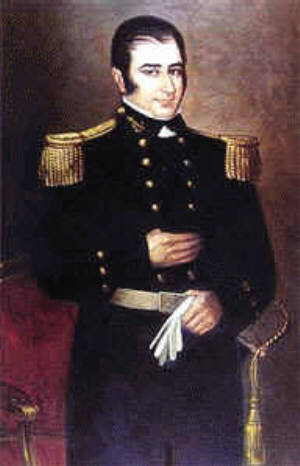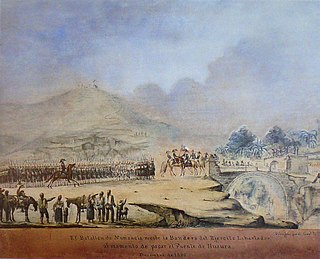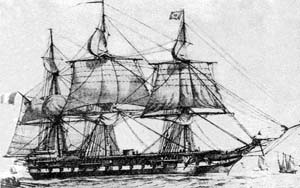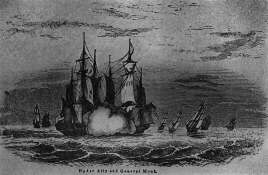
Admiral Thomas Cochrane, 10th Earl of Dundonald, Marquess of Maranhão, styled Lord Cochrane between 1778 and 1831, was a British naval officer, politician and mercenary. Serving during the French Revolutionary and Napoleonic Wars in the Royal Navy, his naval successes led Napoleon to nickname him le Loup des Mers. He was successful in virtually all of his naval actions.

Hippolyte or Hipólito Bouchard, known in California as Pirata Buchar, was a French-born Argentine sailor and corsair (pirate) who fought for Argentina, Chile, and Peru.

The Battle of Angamos was a naval encounter of the War of the Pacific fought between the navies of Chile and Perú at Punta Angamos, on 8 October 1879. The battle was the culminating point of a naval campaign that lasted about five months in which the Chilean Navy had the sole mission of eliminating its Peruvian counterpart. In the struggle, two armored frigates, led by Commodore Galvarino Riveros Cárdenas and Navy Captain Juan José Latorre battered and later captured the Peruvian monitor Huáscar, under Rear Admiral Miguel Grau Seminario.

HMS Speedy was a 14-gun Speedy-class brig of the British Royal Navy. Built during the last years of the American War of Independence, she served with distinction during the French Revolutionary Wars.

The Battle of Callao occurred on May 2, 1866, between a Spanish fleet under the command of Admiral Casto Méndez Núñez and the fortified battery emplacements of the Peruvian port city of Callao during the Chincha Islands War. The Spanish fleet bombarded the port of Callao, and eventually withdrew without any notable damage to the city structures, according to the Peruvian and American sources; or after having silenced almost all the guns of the coastal defenses, according to the Spanish accounts and French observers. This proved to be the final battle of the war between Spanish and Peruvian forces.

The Chincha Islands War, also known as Spanish–South American War, was a series of coastal and naval battles between Spain and its former colonies of Peru, Chile, Ecuador, and Bolivia from 1865 to 1879. The conflict began with Spain's seizure of the guano-rich Chincha Islands in one of a series of attempts by Spain, under Isabella II, to reassert its influence over its former South American colonies. The war saw the use of ironclads, including the Spanish ship Numancia, the first ironclad to circumnavigate the world.

Roberto Simpson Winthrop, was a sailor of English origin, nationalized Chilean, who made a career in the Chilean Navy from 1818 and reached the rank of rear-admiral in 1852. Distinguished himself during the Spanish American wars of independence and the War of the Confederation. He was also founder of the Simpson family in Chile, initiator of the first hydrographic works in the country, senator and diplomat.

The Liberating Expedition of Peru was a naval and land military force created in 1820 by the government of Chile in continuation of the plan of the Argentine General José de San Martín to achieve the independence of Peru, and thus consolidate the independence of all former Spanish-American colonies. It was vital to defeat the Viceroyalty of Peru—the center of royalist power in South America—from where royalist expeditions were sent to reconquer the territories lost to the independence fighters.

BAP Apurímac was the second steam frigate of the Peruvian Navy, built in England in 1855 along with the steam schooners Loa and Tumbes as a part of a major build-up of the Navy during the government of President José Rufino Echenique. A veteran of two wars and many internal conflicts, due to her age, she served as training ship in Callao port from 1873 until 17 January 1881, when she was scuttled along with the rest of the Peruvian Navy to prevent capture by Chilean troops who had occupied the port after the defeat of the Peruvian Army in the battles of San Juan and Miraflores.

The Naval campaign of the War of the Pacific or Saltpeter war, was a naval campaign that took place from 1879 to 1884, involving Peru, and Chile, undertaken in order to support land forces in the Atacama Desert. Although the conflict lasted until 1884, the primary naval engagements occurred between 1879 and 1880. Due to the rough terrain and few transport methods it was imperative to have control of the ports in order to have a good supply source in the region. It resulted in a successful campaign by Chile, and the success of their land campaigns eventually led to a Chilean victory, which cut off Bolivia's access to the coast.

The Battle of Delaware Bay, or the Battle of Cape May, was a naval engagement fought between the Kingdom of Great Britain and the United States during the American Revolutionary War. A British squadron of three vessels attacked three American privateers that were escorting a fleet of merchantmen. The ensuing combat in Delaware Bay near Cape May ended with an American victory over a superior British force.

Águila was the first naval vessel of the Chilean Navy. She was later renamed Pueyrredón.

Lautaro was initially the British East Indiaman Windham, built by Perry, Wells & Green at the Blackwall Shipyard for the East India Company (EIC) and launched in 1800. She made seven voyages to India, Ceylon, and China for the EIC. In 1809–10, the French captured her twice, but the British also recaptured her twice. The Chilean Navy bought her in 1818 and she then served in the Chilean Navy, taking part in several actions during the liberation wars in Chile and Peru. From 1824 she was a training ship until she was sold in 1828.

Esmeralda was a 44-gun frigate built in Port Mahón, Balearic Islands in 1791 for the Spanish Navy. The First Chilean Navy Squadron, under the command of Thomas Cochrane, captured her on the night of 5 November 1820. She was renamed Valdivia in Chilean service. She was beached at Valparaíso in June 1825.

The First Chilean Navy Squadron was the heterogeneous naval force that terminated Spanish colonial rule in the Pacific and protagonized the most important naval actions of in the Latin American wars of independence. The Chilean revolutionary government organized the squadron in order to carry the war to the Viceroyalty of Perú, then the center of Spanish power in South America, and thus secure the independence of Chile and Argentina.

The Capture of the frigate Esmeralda was a naval operation conducted on the night of 5 to 6 November 1820. A division of boats with sailors and marines of the First Chilean Navy Squadron, commanded by Thomas Cochrane, stealthily advanced towards Callao and captured the ship through a boarding attack. Esmeralda was the flagship of Spanish fleet and the main objective of the operation. She was protected by a strong military defense that the Royalists had organized in the port.

BAP Unión was a corvette of the Peruvian Navy, originally ordered by the government of the Confederate States of America during the American Civil War. Built in France it was bought by the Peruvian Navy and during its service participated in the Chincha Islands War and in the War of the Pacific in which it was scuttled following the Blockade of Callao to prevent it falling into Chilean hands. The current Peruvian training ship; BAP Unión, is named after this vessel.

Manuel José Ferreyros y Senra was a Peruvian Navy officer, diplomat and politician. Ferreyros was a friend and comrade-in-arms of Miguel Grau, Aurelio García and Lizardo Montero, who were known as the "Four Aces of the Peruvian Navy". Unlike his comrades-in-arms, Ferreyros did not participate in the War of the Pacific, as he died prematurely, three years before the conflict broke out. His younger brother, Captain Carlos Ferreyros, fought in the war, commanding the gunboat Pilcomayo.

The Thomas Cochrane campaign was a series of mainly naval war actions carried out by the admiral hired by the Chilean government, Thomas Cochrane, who was also given Chilean nationality. Cochrane had been assigned the objective of the Chilean government to end Spanish naval power in the Pacific, mainly the port of Callao and achieve control of the Pacific Ocean. He carried out several actions to achieve his goal, in addition to participating in the attack of objectives on land such as the capture of Valdivia or Pisco.

Berenguela was a screw frigate of the Spanish Navy commissioned in 1857. She took part in the mulitnational intervention in Mexico in 1861–1862, several actions during the Chincha Islands War of 1865–1866, and the Spanish-Moro conflict in the early 1870s and was the first Spanish Navy ship to transit the Suez Canal. She was disarmed in 1875 and decommissioned in 1877.




















